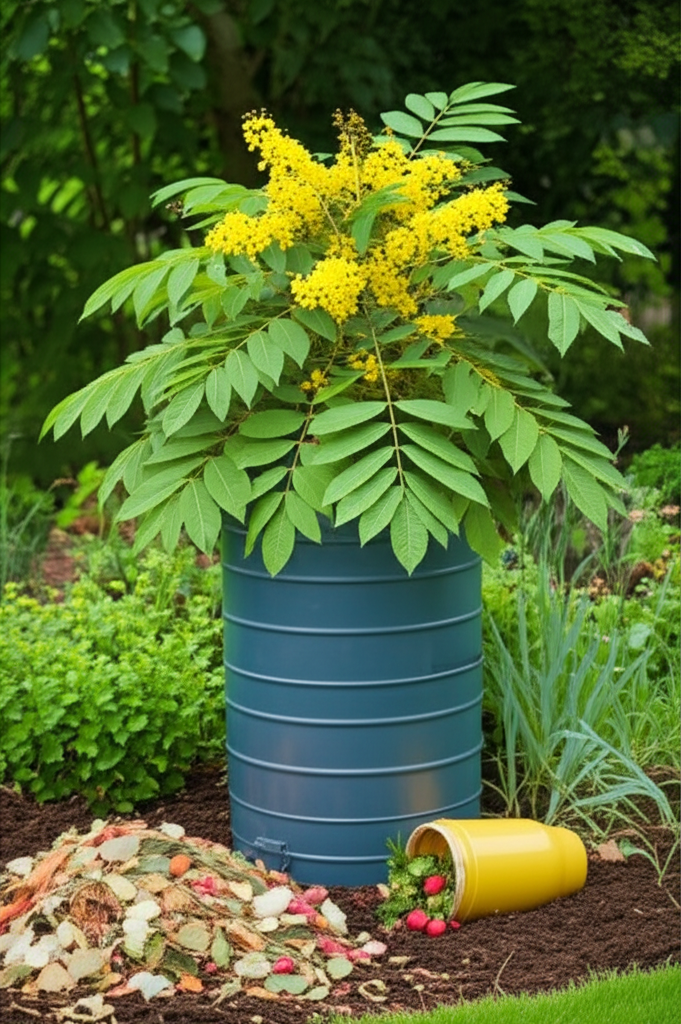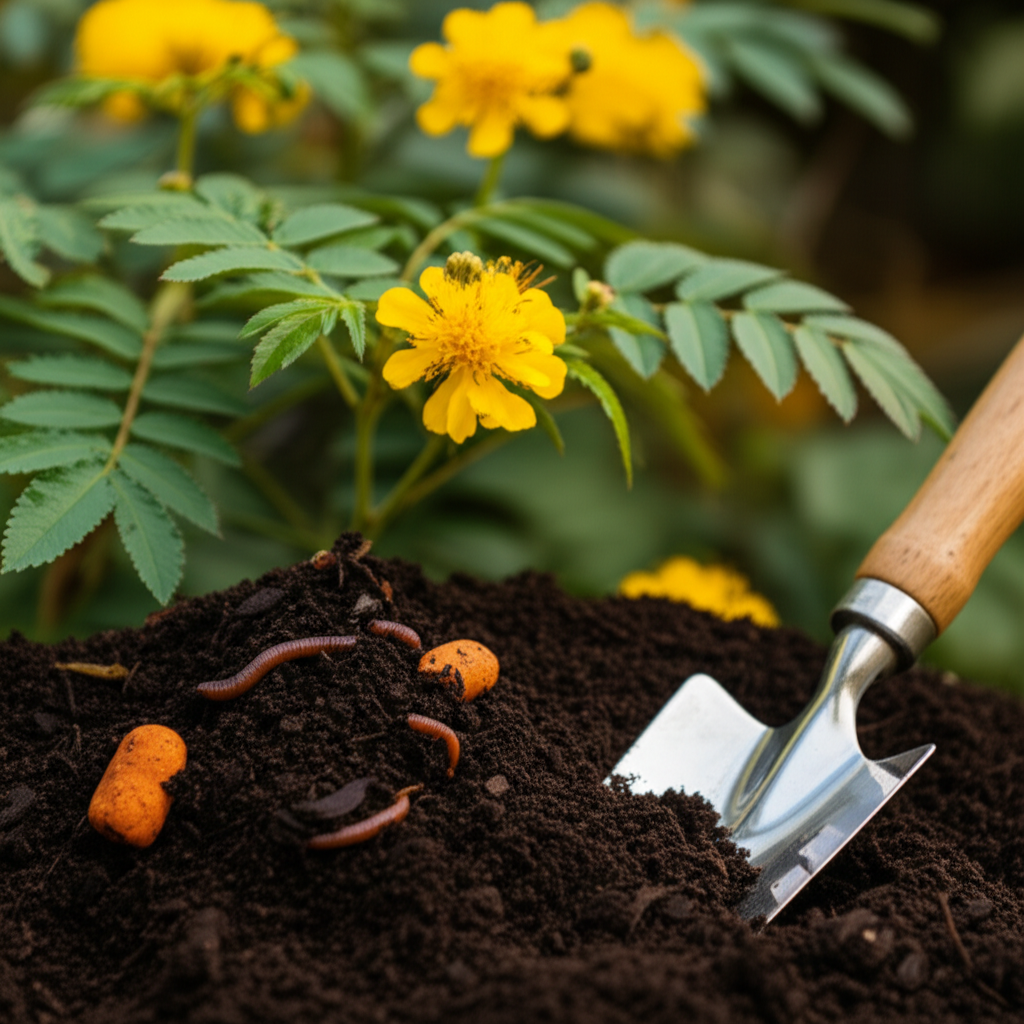Can Candle Bush Be Composted? Turning Your Garden Waste into Black Gold

Have you ever looked at your wilting Candle Bush (Senna alata) and wondered if its fallen leaves and spent blooms could be more than just yard waste? What if we told you that this vibrant plant, often admired for its striking yellow flowers, could also be a valuable asset to your composting efforts, transforming into nutrient-rich “black gold” for your garden? Understanding how to effectively compost plant material is fundamental to creating a thriving, sustainable garden, and unlocking the composting potential of plants like the Candle Bush can significantly boost your soil’s fertility and reduce your reliance on synthetic fertilizers.
Quick Answer Box
Yes, the Candle Bush can be composted, provided it is properly prepared and balanced within your compost pile. The leaves, stems, and spent flowers of the Candle Bush can break down effectively, adding valuable organic matter and nutrients to your compost, but it’s important to manage the moisture and carbon-to-nitrogen ratio for optimal decomposition.
What is Candle Bush and Why It’s Important in Gardening?
The Candle Bush, scientifically known as Senna alata, is a tropical shrub or small tree celebrated for its dramatic, upright spikes of bright yellow flowers that resemble lit candles. Native to the Americas, it’s a popular ornamental plant in warmer climates, often planted for its aesthetic appeal and its natural ability to attract pollinators. Beyond its beauty, the Candle Bush holds a place in traditional medicine, with various parts of the plant historically used for their laxative and antifungal properties.
In the context of gardening, understanding the properties of any plant is crucial for its care and for managing its lifecycle. For the Candle Bush, this means recognizing its growth habits, its potential to spread, and what to do with it once its blooming season is over or if it needs to be pruned. Its leaves are relatively large and can decompose fairly readily, while its woody stems will require more time. By considering its compostability, gardeners can extend the plant’s contribution to the garden’s ecosystem, turning what might otherwise be discarded into a vital soil amendment.
Quick Recommendations or Key Insights about Candle Bush and Composting
Chop it Up: Smaller pieces of Candle Bush material decompose much faster.
Balance is Key: Mix Candle Bush with “brown” materials (carbon-rich) like dried leaves and cardboard.
Moisture Matters: Keep the compost pile consistently moist, like a wrung-out sponge.
Monitor Your Pile: Turn your compost regularly to aerate it and speed up decomposition.
Avoid Diseased Material: If your Candle Bush shows signs of disease, it’s best not to compost it to prevent spreading pathogens.
Detailed Breakdown of Candle Bush and Composting
The Scientific Perspective: Decomposition and Plant Biology
Composting is essentially a controlled process of decomposition, where microorganisms (bacteria, fungi) and macroorganisms (worms, insects) break down organic matter into a stable, nutrient-rich material. The rate at which organic matter decomposes depends on several factors, including the carbon-to-nitrogen ratio (C:N), moisture content, temperature, and aeration.
The Candle Bush, like most leafy plants, contains a good amount of nitrogen, primarily found in its leaves and softer tissues. Nitrogen is essential for the microorganisms that drive the composting process, acting as their protein source. However, if too much green, nitrogen-rich material is added to a compost pile without sufficient carbon-rich “brown” materials, the pile can become dense, anaerobic (lacking oxygen), and develop foul odors. This imbalance can slow down decomposition significantly and lead to the production of ammonia gas.
The woody stems of the Candle Bush will decompose more slowly than its leaves. Woodier materials have a higher carbon content and a lower nitrogen content, which is why they are classified as “browns.” When composting the Candle Bush, it’s important to consider the different parts of the plant. The leaves and flowers will break down relatively quickly, acting as “greens,” while the more mature stems will act as “browns” but will require more time and potentially smaller particle size to decompose effectively.
Practical Applications in the Garden
Integrating composted Candle Bush into your garden practices offers numerous benefits. Once decomposed, the resulting compost is a fantastic soil conditioner. When you add it to your garden beds, it improves soil structure, aeration, and water retention. This means healthier roots, less soil compaction, and a more resilient garden, especially in drier conditions.
Enriching Soil: Mix composted Candle Bush into your vegetable beds before planting to provide essential nutrients.
Mulching: A layer of finished compost around the base of plants can help suppress weeds, retain soil moisture, and slowly release nutrients.
Potting Mix Enhancement: Blend finished compost with potting soil to create a nutrient-dense mix for container plants.
Compost Tea: While less common for specific plant composts, the finished product can be used to brew compost tea, a liquid fertilizer that can be sprayed on foliage or applied to the soil.
Common Mistakes to Avoid
Composting Too Much at Once: Adding a large quantity of Candle Bush material, especially fresh green material, without adequate brown materials can create an anaerobic and smelly pile.
Not Chopping Material: Large leaves and stems will take significantly longer to break down. Without chopping, they can remain recognizable for months, hindering the overall composting process.
Ignoring Moisture Levels: A compost pile that is too wet can become anaerobic and rot, while a pile that is too dry will halt decomposition.
Composting Diseased or Pest-Infested Plants: If your Candle Bush has suffered from significant fungal diseases or pest infestations, it’s generally best to avoid adding it to your compost to prevent spreading these issues to your garden. While high temperatures in a well-managed compost pile can kill many pathogens, it’s a risk best avoided for sensitive plants.
Not Balancing Greens and Browns: Over-reliance on nitrogen-rich “greens” like Candle Bush leaves will lead to a sluggish, smelly pile. You need to ensure a good mix of carbon-rich “browns” to achieve efficient decomposition.
Expert Tips or Pro Insights
Layering Technique: When adding Candle Bush to your compost bin, try layering it with a good amount of dry leaves, shredded cardboard, or straw. This ensures proper aeration and C:N balance from the start.
Particle Size is Paramount: For faster decomposition, especially of the stems, run over the plant material with a lawnmower or shred it using a chipper/shredder. Even a good chopping with shears will make a difference.
Active Composting: To speed things up, aim for an actively managed compost pile. This involves regular turning (every 1-2 weeks) to introduce oxygen and mixing the materials thoroughly.
Pre-Composting: If you have a large amount of Candle Bush material, consider a pre-composting step. Pile it up separately for a few weeks to allow initial breakdown before adding it to your main compost bin. This helps manage the “green” load.
Know Your Bin: Different compost bins have different aeration and moisture retention properties. Understand your bin’s characteristics to best manage its contents. Open bins may dry out faster, while enclosed bins can retain more moisture.
Seasonal or Climate Considerations
The seasonality of Candle Bush and its composting suitability can vary depending on your climate.
Tropical and Subtropical Climates: In regions where Candle Bush thrives year-round, you may have a consistent supply of trimmings and fallen material. This allows for continuous composting, but it also means you need to be diligent about balancing your compost inputs throughout the year. Warmer temperatures naturally speed up decomposition.
Temperate Climates: In areas with cooler winters or frost, the Candle Bush may die back or need to be pruned heavily in the fall. This can result in a large volume of material needing to be composted at once. It’s crucial to have a good supply of “brown” materials (fallen leaves, shredded paper) on hand in the fall to balance this influx of “green” material. Decomposition will slow down considerably in cooler weather, so plan accordingly. You might consider a slower, cold composting method during winter months.
Drying Material: In very humid climates, fresh Candle Bush material might be excessively wet, requiring more careful balancing with dry browns to prevent sogginess and anaerobic conditions. Conversely, in very dry climates, you might need to add more water to keep the compost pile at the optimal moisture level.
Buying Guide or Decision-Making Process
This section is less about buying a product and more about deciding how to best utilize your Candle Bush for composting. When you have Candle Bush material to compost, consider these factors:
Quantity: How much material do you have? A small amount can be added directly to an existing compost pile. A large amount might require a dedicated composting area or a careful, layered approach to avoid overwhelming your bin.
Plant Condition: Is the plant healthy, or does it show signs of disease or pests? Composting healthy material is always recommended. If diseased, consider alternatives like municipal green waste disposal or hot composting if you have the setup.
Your Composting System: Do you have a simple backyard compost bin, a tumbler, a worm farm, or a more advanced hot composting system? The volume and type of Candle Bush material you add should be appropriate for your chosen method. Worm farms, for instance, are best with smaller, finely chopped green materials.
Availability of Other Materials: Do you have a good supply of brown materials (carbon-rich) like dry leaves, straw, shredded paper or cardboard, sawdust, or wood chips? Without these, your Candle Bush will not compost efficiently.
FAQ Section for Candle Bush and Composting
Q1: Can I compost the woody stems of the Candle Bush?
A1: Yes, you can compost the woody stems, but they will decompose much more slowly than the leaves and flowers. For faster breakdown, it’s highly recommended to chop them into small pieces or shred them.
Q2: Will composting Candle Bush make my compost smell bad?
A2: If your compost pile becomes smelly, it’s usually due to an imbalance of nitrogen and carbon, or lack of oxygen. Ensure you mix the Candle Bush with plenty of brown materials (like dry leaves or cardboard) and turn the pile regularly to keep it aerated and prevent anaerobic conditions.
Q3: How long does it take for Candle Bush to compost?
A3: The decomposition time varies greatly depending on how you manage your compost. With proper chopping, good aeration, moisture, and balancing of materials, Candle Bush leaves and flowers can break down in a few months. Woody stems might take six months to a year or even longer.
Q4: Can I add all parts of the Candle Bush to my compost?
A4: Generally, yes, all parts can be composted. However, if the plant has any significant fungal diseases or is heavily infested with pests, it’s safer to avoid composting it to prevent spreading these issues.
Q5: Should I add water to the compost pile if I add Candle Bush?
A5: Candle Bush material can sometimes be quite moist. Assess the overall moisture of your compost pile. If it feels dry, add water. If it feels very wet and soggy, add more brown, absorbent materials instead of water. The goal is a consistently moist, like a wrung-out sponge, but not saturated, pile.
Conclusion for Candle Bush and Composting
Embracing the composting potential of your Candle Bush is a fantastic way to enrich your garden soil naturally and sustainably. By understanding the principles of decomposition and applying simple techniques like chopping material, balancing greens and browns, and ensuring adequate moisture and aeration, you can transform this ornamental plant into a valuable resource. This process not only reduces garden waste but also creates nutrient-dense compost that will nourish your soil, promote healthier plant growth, and contribute to a more vibrant and resilient garden ecosystem. Start composting your Candle Bush today and witness the magic of turning garden waste into your own black gold.


